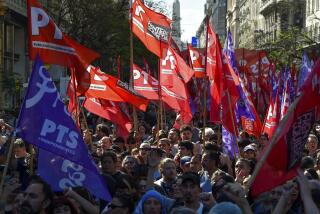International Business : BRIEFING BOOK : Argentina’s Privatization Wave Expected to Broaden Its Market
- Share via
ISSUE: In the privatization wave sweeping Latin America, Argentina is the first country to auction off one of the region’s big, state-owned oil monopolies--longtime sacred cows for nationalists of the right and left. The selloff of Yacimientos Petrolifer os Fiscales has been billed as the biggest privatization in Latin American history.
President Carlos Menem’s administration argued that both the government and YPF would be more efficient with the oil company private and that the selloff was needed to help pay a multibillion-dollar debt to social security pensioners.
The YPF sale was part of a massive privatization program that has also included gas and electric utilities, the telephone company and the national airline. Privatization has brought in more than $8 billion in cash and reduced Argentina’s foreign debt by $7 billion.
BACKGROUND: In preparation for the privatization, YPF was streamlined through the sale of several subsidiaries and the slashing of a payroll of 51,000 workers to 10,000. The company’s balance sheet turned sharply from a loss of $576 million in 1990 to net income of $259 million last year.
YPF “has worked very hard to reduce costs and become efficient over the past three years,” said a diplomatic analyst.
American Depository Shares for YPF stock have been a popular issue on the New York Stock Exchange since the public offering--about 45% of the company’s shares--in late June. Of $3 billion in proceeds from the public offering, $1.4 billion came from the United States.
From its initial price of $19, YPF reached a high of $26.25 on the NYSE on Tuesday. In addition to the shares placed in the public offering, the government distributed 10% of YPF shares to company employees. The national government will retain 20% ownership of the company, the governments of oil-producing provinces 11%, and remaining shares are expected to be issued in a swap for social security pension bonds outstanding.
OUTLOOK: YPF owns ample reserves in a country that has been under-explored for oil and has more gas than it can use.
But much of the company’s moneymaking potential is downstream, where it controls more than half of Argentina’s outlets for gasoline--giving it a strong hand in setting prices. The bulk of Argentine petroleum is consumed internally.
The company had a $157-million profit in the second quarter, and third-quarter earnings to be announced in November will indicate whether YPF will meet projections of a $600-million profit this year and up to $1 billion next year. If stock analysts begin to believe that these targets will be met, then YPF stock “has a lot more upside,” said Walter J. Stoeppelwerth, senior analyst in Buenos Aires for Smith New Court Securities Ltd.
STRATEGY: YPF has quickly become the bellwether of the Buenos Aires stock exchange. The Argentine price of YPF is set on the NYSE. Argentine traders use YPF’s price in New York as a barometer of foreign financial confidence in Argentina. As a result, YPF movements in New York can and often do move the Buenos Aires stock market.
Brokers say Argentine investors who have enjoyed fast gains with YPF are now venturing into other domestic stocks, especially the Telefonica Argentina phone company. This is adding breadth to the Argentine exchange, Stoeppelwerth said.
“YPF has injected new life in the stock market here, without a doubt,” he said.
The continuation of Argentina’s privatization program is expected to further broaden the country’s stock market, where about 68% of the market capitalization is represented by the 10 largest stocks. In 1994, the government plans to begin issuing shares it retained in previously privatized companies, including two electric generating plants and 10 gas companies. The government has retained 25% to 30% ownership of many privatized companies.
Some analysts predict a strong new stage of development in the Argentine stock market, which delighted foreign investors with booming growth in 1991 but slumped badly in 1992.
More to Read
Sign up for Essential California
The most important California stories and recommendations in your inbox every morning.
You may occasionally receive promotional content from the Los Angeles Times.










